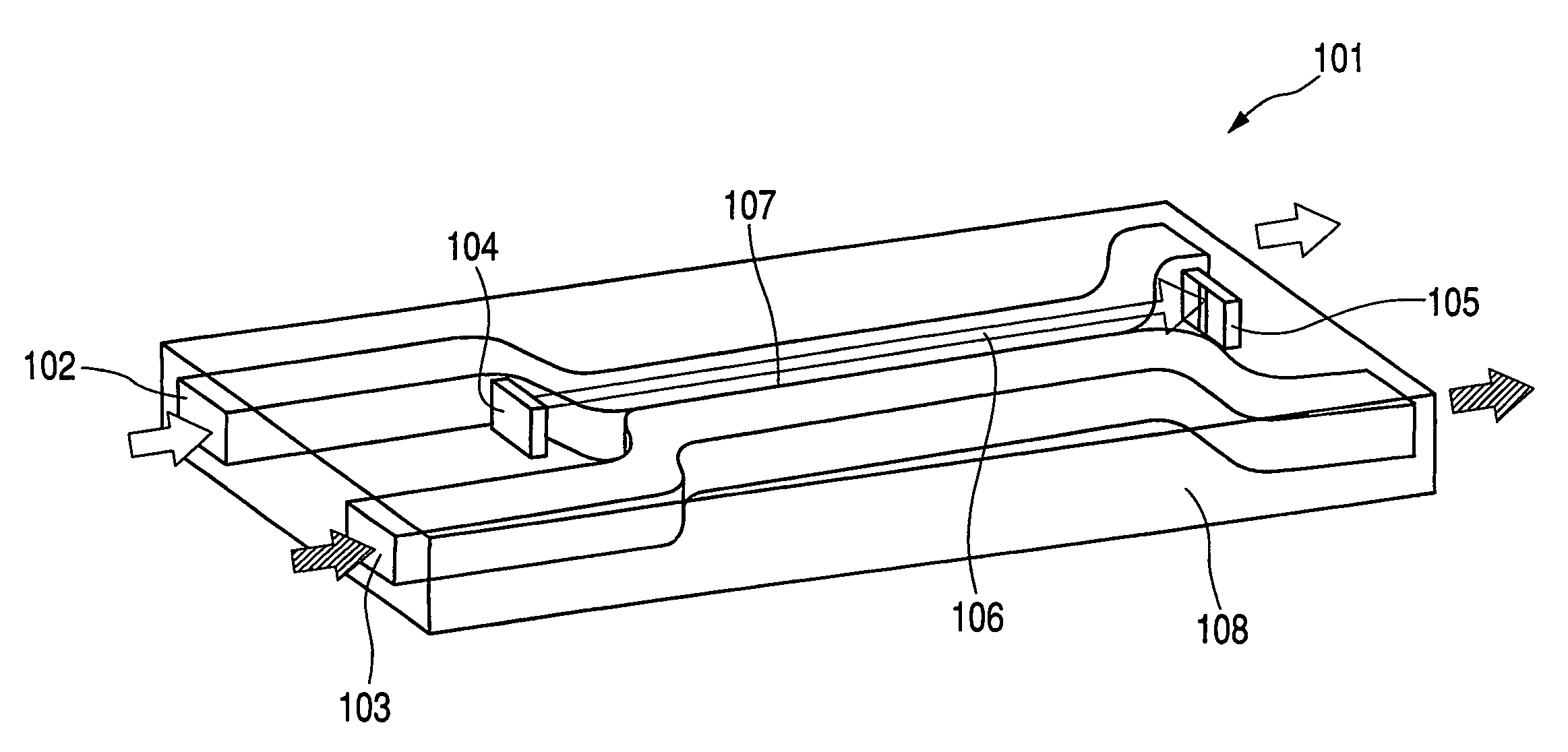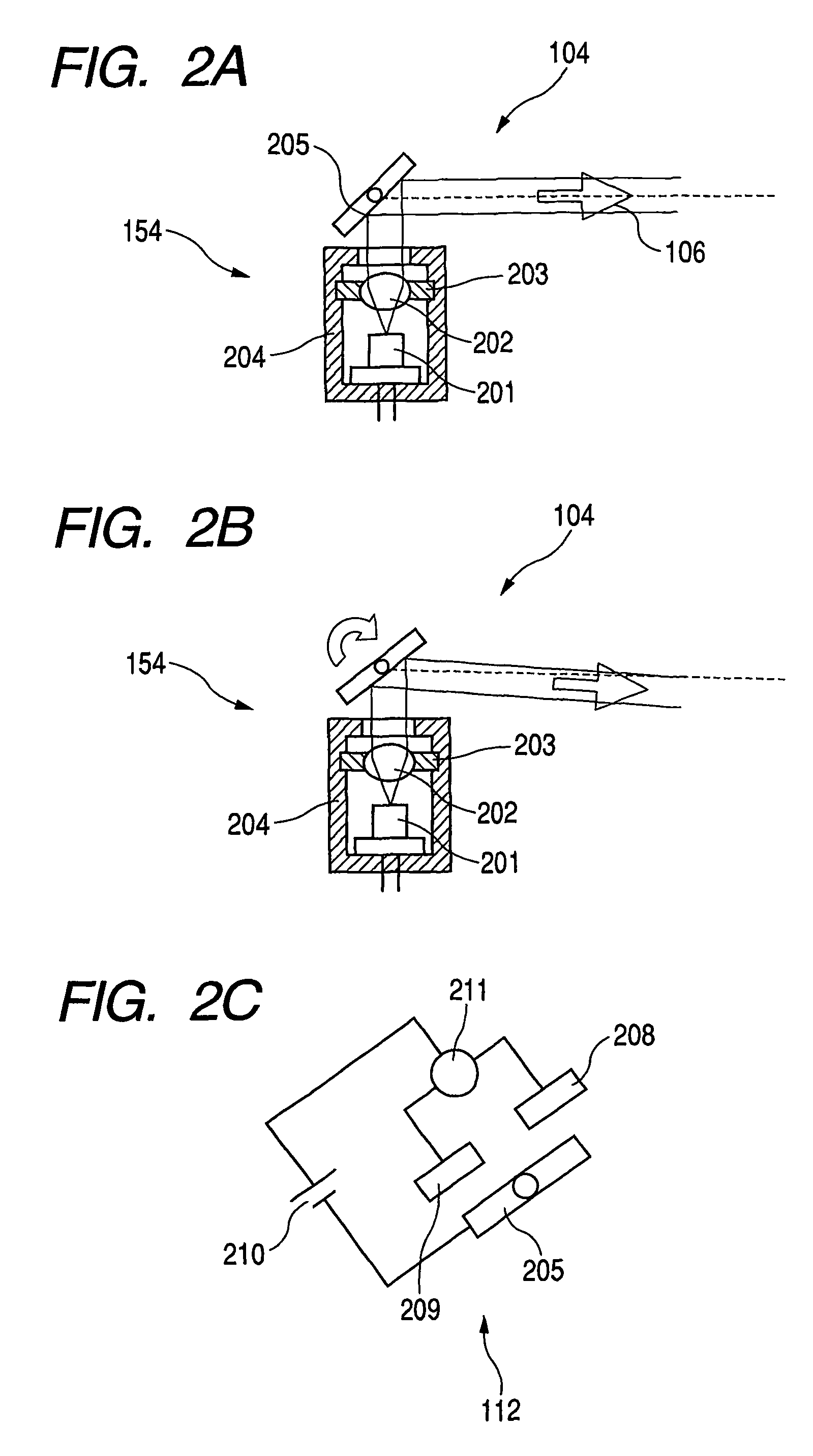Detection device and detection method
a detection device and detection method technology, applied in the field of detection devices and detection methods, can solve the problems of low measurement accuracy, difficulty in utilizing -tas in the optical detection method employing conventional, and low integration, and achieve high integration, high precision, and easy production
- Summary
- Abstract
- Description
- Claims
- Application Information
AI Technical Summary
Benefits of technology
Problems solved by technology
Method used
Image
Examples
first embodiment
[0047]A first embodiment of the present invention is a concentration detection device of a GRIN prism system employing asymmetric flow channels. Firstly, the basic constitution is explained of the concentration detection device of this embodiment.
[0048]FIG. 1 is a perspective view illustrating schematically the concentration detection device of this embodiment consisting of a plate-shaped functional module 101. This functional module 101 is used for determination of a concentration of an examination-objective substance in a fluid to be examined. Functional module 101 has reference flow channel 102, and examination flow channel 103 for flow of the examination-objective fluid. The widths of the flow channels range from 10 μm to 100 μm. Reference flow channel 102 and examination flow channel 103 are partitioned with semipermeable membrane 107. Therefore, the semipermeable membrane constitutes the wall between the adjacent flow channels, whereby a substance can permeate through semiperm...
second embodiment
[0065]A second embodiment is explained below by reference to FIGS. 6 and 7. In FIGS. 6 and 7, the same members as in First Embodiment are denoted by the same symbols without explanation.
[0066]The detection device of this Embodiment, as shown in FIG. 6, similarly as First Embodiment, is provided with reference flow channel 401 and examination flow channel 402 with interposition of semipermeable membrane 107; detection light 407 is allowed to pass through reference flow channel 401; and the transmitted detecting light is received by two photodiodes 411, 410 of a two-division sensor to detect the differential signal.
[0067]The detection device of this Embodiment is constituted characteristically of a light-emission unit (not shown in the drawing), flow channel portion 408, and detection unit 409 as separate modules respectively connected in series. To avoid interference between the introduction and the discharge of the fluid to or from flow channels 401, 402 in the serial connection, in...
third embodiment
[0071]A third embodiment of the present invention is explained below by reference to FIGS. 8 and 9A to 9D. In FIGS. 8 and 9A to 9D, the same members as in First and Second Embodiments are denoted by the same symbols without explanation.
[0072]The detection device of this Embodiment comprises one reference flow channel 601, and two examination flow channels 602, 603 placed on the both sides of the reference channel with interposition of semipermeable membrane 107 respectively. Detecting light 604 is allowed to pass through reference flow channel 601, and the differential signal is detected by receiving detecting light 604 by two photodiodes 605, 606 of a two-division sensor.
[0073]In this Embodiment, different examination-objective fluids are allowed to flow through upper examination flow path 602 and lower examination flow path 603 on the both sides of reference flow channel 601. Thereby, the concentration distributions of the detection-objective substances in reference flow channel 6...
PUM
| Property | Measurement | Unit |
|---|---|---|
| width | aaaaa | aaaaa |
| widths | aaaaa | aaaaa |
| concentration | aaaaa | aaaaa |
Abstract
Description
Claims
Application Information
 Login to View More
Login to View More - R&D
- Intellectual Property
- Life Sciences
- Materials
- Tech Scout
- Unparalleled Data Quality
- Higher Quality Content
- 60% Fewer Hallucinations
Browse by: Latest US Patents, China's latest patents, Technical Efficacy Thesaurus, Application Domain, Technology Topic, Popular Technical Reports.
© 2025 PatSnap. All rights reserved.Legal|Privacy policy|Modern Slavery Act Transparency Statement|Sitemap|About US| Contact US: help@patsnap.com



